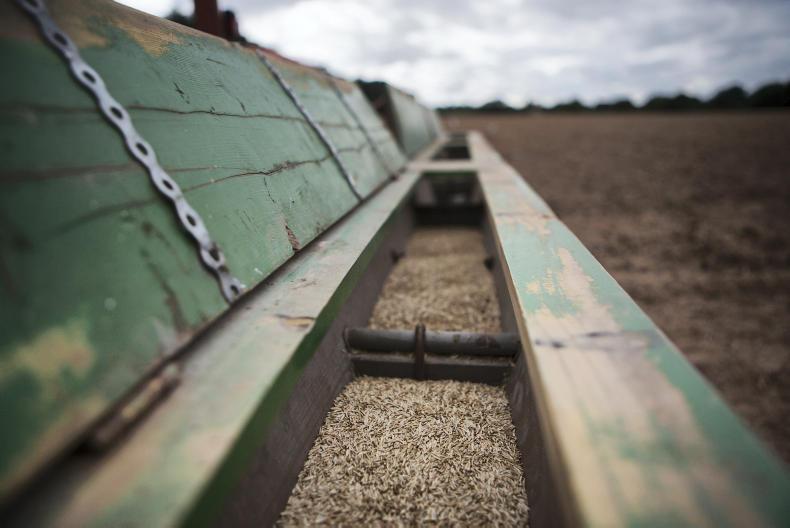The objective of arable grass margins in GLAS III is to provide a habitat for flora and fauna, increase biodiversity and help protect water quality.
Where established along a watercourse, it acts as a buffer zone to intercept sediment and nutrients.
Where the margin is established along a watercourse, an additional 2m unsown (with an arable crop) and unfertilised margin must be in place between the watercourse and the arable grass margin.
Requirements
Under this action, the Department of Agriculture has outlined seven requirements which farmers must undertake to comply with this action:
1. Establish a 3m, 4m or 6m grass margin along the full length of an LPIS parcel or field boundary.
The arable grass margin must be established by 31 May 2017 on all the selected tillage parcels GLAS participants were approved on for this action.
2. The location and length (metres) must be identified on the LPIS parcel(s) and marked on the map submitted. The margin(s) must remain in the same location for the duration of the contract.
Participants can choose different arable grass margin widths within the same LPIS parcels, but only on different/separate field/LPIS boundaries.
3. Sow a grass seed mix containing at least 60% Cocksfoot or Timothy or a combination of these at the rate of 25kg to 30kg/ha.
Alternatively a participant can opt to include wild flower species along with the 60% Cocksfoot or Timothy grass seed mix, provided that the Cocksfoot/Timothy seed rate does not drop below 25kg/ha.
Where the wild flower mix is being sown, it should be sown at the rate recommended by the manufacturer/seed distributor.
All seed labels and receipts must be kept for the duration of the GLAS contract.
4. Soil cultivation cannot be carried out within the margin once established.
5. The margin must be mulched, mown or grazed at least once per year, but not between 1 March and 15 August annually. Off takes can be removed.
6. Fertiliser or lime cannot be applied to the margin.
7. Pesticides cannot be applied to the margin except for the spot treatment of noxious and/or invasive weeds.
Recommendations
Where possible, wild flower seeds should be natively sourced, the Department advises.
Where wildflowers are included in the arable grass margin, participants should delay cutting until after seed set and remove cuttings where possible.
Mulching is not recommended for wildflower mixes.
Take note
Farmers should note that if they select this action, the only other actions they can select on this LPIS parcel are: bat boxes, bird boxes, conservation of solitary bees (boxes/sand), grey partridge, coppicing of hedgerows, laying of hedgerows, low emission slurry spreading, protection and maintenance of archaeological monuments (tillage), rare breeds and traditional dry stone wall maintenance.
Read more
Full coverage: GLAS countdown
The objective of arable grass margins in GLAS III is to provide a habitat for flora and fauna, increase biodiversity and help protect water quality.
Where established along a watercourse, it acts as a buffer zone to intercept sediment and nutrients.
Where the margin is established along a watercourse, an additional 2m unsown (with an arable crop) and unfertilised margin must be in place between the watercourse and the arable grass margin.
Requirements
Under this action, the Department of Agriculture has outlined seven requirements which farmers must undertake to comply with this action:
1. Establish a 3m, 4m or 6m grass margin along the full length of an LPIS parcel or field boundary.
The arable grass margin must be established by 31 May 2017 on all the selected tillage parcels GLAS participants were approved on for this action.
2. The location and length (metres) must be identified on the LPIS parcel(s) and marked on the map submitted. The margin(s) must remain in the same location for the duration of the contract.
Participants can choose different arable grass margin widths within the same LPIS parcels, but only on different/separate field/LPIS boundaries.
3. Sow a grass seed mix containing at least 60% Cocksfoot or Timothy or a combination of these at the rate of 25kg to 30kg/ha.
Alternatively a participant can opt to include wild flower species along with the 60% Cocksfoot or Timothy grass seed mix, provided that the Cocksfoot/Timothy seed rate does not drop below 25kg/ha.
Where the wild flower mix is being sown, it should be sown at the rate recommended by the manufacturer/seed distributor.
All seed labels and receipts must be kept for the duration of the GLAS contract.
4. Soil cultivation cannot be carried out within the margin once established.
5. The margin must be mulched, mown or grazed at least once per year, but not between 1 March and 15 August annually. Off takes can be removed.
6. Fertiliser or lime cannot be applied to the margin.
7. Pesticides cannot be applied to the margin except for the spot treatment of noxious and/or invasive weeds.
Recommendations
Where possible, wild flower seeds should be natively sourced, the Department advises.
Where wildflowers are included in the arable grass margin, participants should delay cutting until after seed set and remove cuttings where possible.
Mulching is not recommended for wildflower mixes.
Take note
Farmers should note that if they select this action, the only other actions they can select on this LPIS parcel are: bat boxes, bird boxes, conservation of solitary bees (boxes/sand), grey partridge, coppicing of hedgerows, laying of hedgerows, low emission slurry spreading, protection and maintenance of archaeological monuments (tillage), rare breeds and traditional dry stone wall maintenance.
Read more
Full coverage: GLAS countdown






 This is a subscriber-only article
This is a subscriber-only article





SHARING OPTIONS: